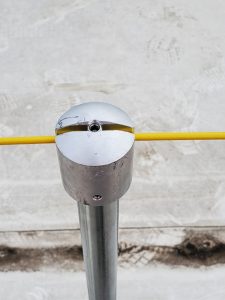Warning Lines
Warning Lines serve as visual reminders of the defined work area, clearly marking areas where workers do not belong. Diversified Fall Protection’s Warning Lines are built to last and are an excellent complement to a comprehensive fall protection system and program.


Warning Lines

Warning Lines

Warning Lines

Although your work area may be deemed OSHA compliant with fall protection warning lines in place, it is important to remember that these systems do NOT physically restrain workers from traveling into dangerous areas nor do they arrest falls. Before utilizing a warning line fall protection system, be sure to contact a qualified fall protection company to explore all potential options to keep your employees safe while working at heights.
Gen-2 Permanent Roof Warning Line System Features
- Compact, non-penetrating concrete base
- Galvanized stanchion posts and fittings
- Heavy duty molded plastic warning flags for long service life
- Aluminum top cap set screw design secures warning line per OSHA regs
- OSHA 1910.29 (d) and 1926.502 ( f)(2) compliant
System Specs
- Stanchion assembly height – 39″
- Base dimensions – 18" x 24" x 2.5" / 85 Lbs
OSHA Regulations
OSHA Warning Line Regulations for General Industry
- 1910.29(d) Designated areas.
- 1910.29(d)(1) When the employer uses a designated area, the employer must ensure:
- 1910.29(d)(1)(i) Employees remain within the designated area while work operations are underway; and
- 1910.29(d)(1)(ii) The perimeter of the designated area is delineated with a warning line consisting of a rope, wire, tape, or chain that meets the requirements of paragraphs (d)(2) and (3) of this section.
- 1910.29(d)(2) The employer must ensure each warning line:
- 1910.29(d)(2)(i) Has a minimum breaking strength of 200 pounds (0.89 kN);
- 1910.29(d)(2)(ii) Is installed so its lowest point, including sag, is not less than 34 inches (86 cm) and not more than 39 inches (99 cm) above the walking-working surface;
- 1910.29(d)(2)(iii) Is supported in such a manner that pulling on one section of the line will not result in slack being taken up in adjacent sections causing the line to fall below the limits specified in paragraph (d)(2)(ii) of this section;
- 1910.29(d)(2)(iv) Is clearly visible from a distance of 25 feet (7.6 m) away, and anywhere within the designated area;
- 1910.29(d)(2)(v) Is erected as close to the work area as the task permits; and
- 1910.29(d)(2)(vi) Is erected not less than 6 feet (1.8 m) from the roof edge for work that is both temporary and infrequent, or not less than 15 feet (4.6 m) for other work.
- 1910.29(d)(3) When mobile mechanical equipment is used to perform work that is both temporary and infrequent in a designated area, the employer must ensure the warning line is erected not less than 6 feet (1.8 m) from the unprotected side or edge that is parallel to the direction in which the mechanical equipment is operated, and not less than 10 feet (3 m) from the unprotected side or edge that is perpendicular to the direction in which the mechanical equipment is operated.
OSHA Warning Line Regulations for Construction:
- 1926.502(f) "Warning line systems." Warning line systems [See 1926.501(b)(10)] and their use shall comply with the following provisions:
- 1926.502(f)(1) The warning line shall be erected around all sides of the roof work area.
- 1926.502(f)(1)(i) When mechanical equipment is not being used, the warning line shall be erected not less than 6 feet (1.8 m) from the roof edge.
- 1926.502(f)(1)(ii) When mechanical equipment is being used, the warning line shall be erected not less than 6 feet (1.8 m) from the roof edge which is parallel to the direction of mechanical equipment operation, and not less than 10 feet (3.1 m) from the roof edge which is perpendicular to the direction of mechanical equipment operation.
- 1926.502(f)(1)(iii) Points of access, materials handling areas, storage areas, and hoisting areas shall be connected to the work area by an access path formed by two warning lines.
- 1926.502(f)(1)(iv) When the path to a point of access is not in use, a rope, wire, chain, or other barricade, equivalent in strength and height to the warning line, shall be placed across the path at the point where the path intersects the warning line erected around the work area, or the path shall be offset such that a person cannot walk directly into the work area.
- 1926.502(f)(2) Warning lines shall consist of ropes, wires, or chains, and supporting stanchions erected as follows:
- 1926.502(f)(2)(i) The rope, wire, or chain shall be flagged at not more than 6-foot (1.8 m) intervals with high-visibility material;
- 1926.502(f)(2)(ii) The rope, wire, or chain shall be rigged and supported in such a way that its lowest point (including sag) is no less than 34 inches (.9 m) from the walking/working surface and its highest point is no more than 39 inches (1.0 m) from the walking/working surface;
- 1926.502(f)(2)(iii) After being erected, with the rope, wire, or chain attached, stanchions shall be capable of resisting, without tipping over, a force of at least 16 pounds (71 N) applied horizontally against the stanchion, 30 inches (.8 m) above the walking/working surface, perpendicular to the warning line, and in the direction of the floor, roof, or platform edge;
- 1926.502(f)(2)(iv) The rope, wire, or chain shall have a minimum tensile strength of 500 pounds (2.22 kN), and after being attached to the stanchions, shall be capable of supporting, without breaking, the loads applied to the stanchions as prescribed in paragraph (f)(2)(iii) of this section; and
- 1926.502(f)(2)(v) The line shall be attached at each stanchion in such a way that pulling on one section of the line between stanchions will not result in slack being taken up in adjacent sections before the stanchion tips over.
- 1926.502(f)(3) No employee shall be allowed in the area between a roof edge and a warning line unless the employee is performing roofing work in that area
Talk to a fall protection specialist
Tell us about your fall protection needs, and we’ll configure a system that rises to your challenges.

